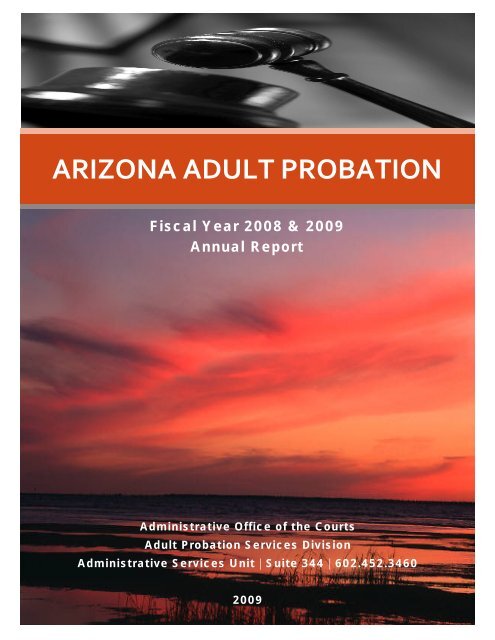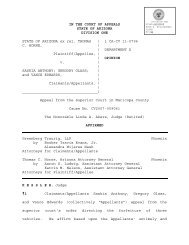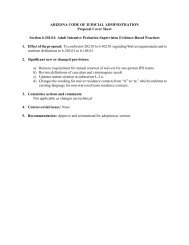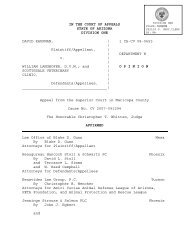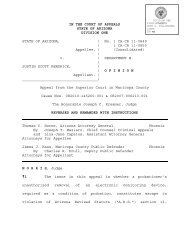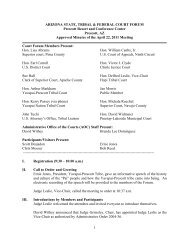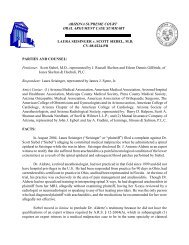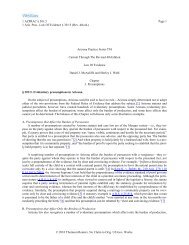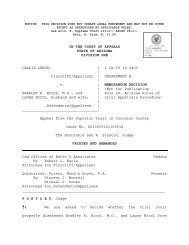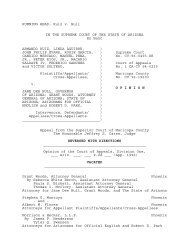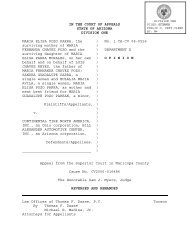ARIZONA ADULT PROBATION - Arizona Judicial Department
ARIZONA ADULT PROBATION - Arizona Judicial Department
ARIZONA ADULT PROBATION - Arizona Judicial Department
Create successful ePaper yourself
Turn your PDF publications into a flip-book with our unique Google optimized e-Paper software.
<strong>ARIZONA</strong> <strong>ADULT</strong> <strong>PROBATION</strong><br />
Fiscal Year 2008 & 2009<br />
Annual Report<br />
Administrative Office of the Courts<br />
Adult Probation Services Division<br />
Administrative Services Unit | Suite 344 | 602.452.3460<br />
2009
<strong>Arizona</strong> Supreme Court<br />
Administrative Office of the Courts<br />
This Report Published By<br />
<strong>ADULT</strong> <strong>PROBATION</strong> SERVICES DIVISION<br />
Kathy Waters, Division Director<br />
JL Doyle, Administrative Services Unit Manager<br />
Maria Aguilar‐Amaya, Researcher / Data Analyst<br />
For additional information about the <strong>Arizona</strong> Adult Probation Population, or for<br />
clarification of any information contained in this report, please contact the <strong>Arizona</strong><br />
Supreme Court, Administrative Office of the Courts, Adult Probation Services Division at<br />
(602) 452‐3460.<br />
This report and previous fiscal year reports are available on the APSD Internet website at:<br />
http://www.supreme.stat.az.us/apsd/azprobpop.htm.<br />
© 2009 <strong>Arizona</strong> Supreme Court, Administrative Office of the Courts. All or any part of<br />
this document may be reproduced and distributed for government or nonprofit educational<br />
purposes, with attribution to the owner.<br />
ADMINISTRATIVE OFFICE OF THE COURTS | 2009<br />
1
Directors Message 2<br />
Introduction 4<br />
Intensive Probation Supervision 5<br />
IPS Personnel 6<br />
IPS Population 7<br />
Standard Probation Supervision 9<br />
Standard Probation Personnel 9<br />
Standard Population 10<br />
Interstate Compact Population 13<br />
ISC Population 13<br />
AZ Probation Population 15<br />
Community Restitution 16<br />
Restitution and Fees 17<br />
Adult Probation Services 18<br />
SB 1476 18<br />
EBP 19<br />
Policy 19<br />
GPS 20<br />
Foreign Born 21<br />
Safety 21<br />
Information Management<br />
Systems 22<br />
APETS 22<br />
ICOTS 22<br />
Glossary 23<br />
Probation Flow Chart 25<br />
Table of Contents<br />
Tables<br />
Table 1.1 – IPS Required Contacts 6<br />
Table 1.2 – IPS Personnel 6<br />
Table 1.3 – IPS County Population 8<br />
Table 2.1 – Standard Required<br />
Contacts 9<br />
Table 2.2 – Standard Personnel 10<br />
Table 2.3 – Standard County<br />
Population 12<br />
Table 3.1 – Incoming ISC<br />
Population 14<br />
Table 3.2 – Outgoing ISC<br />
Population 14<br />
Table 4 – Overall Probation<br />
Population 15<br />
Figures<br />
Figure 1 – IPS Directly Supervised<br />
Population 8<br />
Figure 2 – Standard Directly<br />
Supervised Population 11<br />
Figure 3 – Statewide ISC<br />
Population 13<br />
Figure 4 – Overall Probation<br />
Population 15<br />
Figure 4.1 – Community Restitution<br />
Hours 16<br />
Figure 4.2 – Overall Probation<br />
Population 17<br />
Figure 4.3 – Overall Probation<br />
Population 17<br />
<strong>ADULT</strong> <strong>PROBATION</strong> SERVICES DIVISION | 2009
MISSION<br />
The Adult Probation Services Division promotes<br />
and supports an effective probation system through<br />
the use of Evidence Based Practices that advances<br />
the protection of the community, safety of staff,<br />
and accountability of offenders.<br />
VISION<br />
A Division of professionals who promote a positive<br />
probation environment focused on continuous<br />
improvements, advancing technologies, and<br />
research driven practices.<br />
ADMINISTRATIVE OFFICE OF THE COURTS | 2009<br />
1
DIRECTOR’S MESSAGE<br />
I<br />
am extremely<br />
proud of the<br />
individual and<br />
collective work of<br />
Adult Probation<br />
employees across<br />
the state and here at<br />
the Administrative<br />
Office of the Courts. The Supreme<br />
Court, too, appreciates the important<br />
and challenging work that our<br />
dedicated probation staff perform.<br />
These are professionals who believe in<br />
what they do and who believe that<br />
probation is the best sentencing<br />
option that our courts and criminal<br />
justice system have today. Probation<br />
ensures public safety, holds individuals<br />
accountable for their actions and<br />
promotes positive behavioral changes<br />
in the individuals we are charged with<br />
supervising.<br />
Regardless of the economic<br />
situation, we still have an important<br />
job to do. Adult Probation provides<br />
extremely valuable services to the<br />
community. The public needs to<br />
recognize the vital role of probation<br />
services in public safety and<br />
community well‐being. The work of all<br />
Adult Probation staff helps to meet<br />
the mission of the Adult Probation<br />
Services Division (APSD) by promoting<br />
and supporting an effective probation<br />
system through Evidence Based<br />
Practices.<br />
The organizational development<br />
of probation departments and the<br />
APSD over the past year has been very<br />
successful. Through an Evidence Based<br />
Practices Steering Committee and a<br />
Data Work Group, the continued effort<br />
to implement Evidence Based<br />
Practices statewide has continued to<br />
evolve and has gained much<br />
momentum. This progress includes<br />
conducting risk and needs<br />
assessments and reassessments using<br />
our validated risk and needs<br />
instrument, developing pre‐sentence<br />
reports and case plans based on<br />
<strong>ADULT</strong> <strong>PROBATION</strong> SERVICES DIVISION | 2009
assessment information to focus<br />
attention on criminogenic needs,<br />
focusing attention on medium and<br />
high‐risk offenders, and developing<br />
quality assurance in all that we do.<br />
Successful implementation of<br />
evidence‐based principles in<br />
community corrections organizations<br />
can only be achieved through an equal<br />
and integrated focus on evidence‐<br />
based principles, organizational<br />
development, and collaboration. The<br />
integrated approach provides the<br />
necessary depth and breadth for<br />
lasting systemic change. We are proud<br />
to have worked with the National<br />
Institute of Corrections in following<br />
this approach in Adult Probation in<br />
<strong>Arizona</strong>.<br />
The APSD is committed to<br />
working with and supporting the Adult<br />
Probation <strong>Department</strong>s statewide in<br />
using evidence‐based practices to<br />
enhance public safety through<br />
behavioral change. In this endeavor,<br />
APSD is committed to helping<br />
probation <strong>Department</strong>s achieve<br />
sustained reductions in recidivism and<br />
long term behavioral change in<br />
offenders.<br />
We look forward to our<br />
continuing success. We will continue to<br />
recognize <strong>Arizona</strong>’s Probation system<br />
as one of the best in the country and<br />
we look forward to celebrating our<br />
improvements and successes and in<br />
recognizing staff for outstanding<br />
performance.<br />
ADMINISTRATIVE OFFICE OF THE COURTS | 2009<br />
3
INTRODUCTION<br />
T<br />
here are 15 adult county<br />
probation departments in<br />
<strong>Arizona</strong>: Apache, Cochise,<br />
Coconino, Gila, Graham, Greenlee, La<br />
Paz, Maricopa, Mohave, Navajo, Pima,<br />
Pinal, Santa Cruz, Yavapai, and Yuma.<br />
The Administrative Office of the<br />
Courts funds 14 of the 15 county<br />
probation departments in <strong>Arizona</strong>.<br />
Effective July 1, 2003, the Maricopa<br />
County Adult Probation <strong>Department</strong><br />
became funded by Maricopa County.<br />
Probation is a form of criminal<br />
sentence in which the defendant<br />
agrees to comply with specific court<br />
ordered conditions rather than being<br />
sentenced to jail or prison. While on<br />
probation, the defendant is required to<br />
report to a probation officer, pay fees<br />
and fines, maintain employment, and<br />
at times may be required to pay<br />
restitution and/or complete<br />
community restitution hours.<br />
Defendants are typically sentenced to<br />
intensive or standard supervision.<br />
The information presented in<br />
this report characterizes the adult<br />
probation population statewide during<br />
fiscal years 2008 and 2009. Data<br />
contained in this report are drawn<br />
from the statewide information<br />
management system (APETS) and<br />
monthly statistical reports, as reported<br />
by county adult probation<br />
departments.<br />
<strong>ADULT</strong> <strong>PROBATION</strong> SERVICES DIVISION | 2009
INTENSIVE <strong>PROBATION</strong><br />
I<br />
PS has been in effect in<br />
<strong>Arizona</strong> since July 1,<br />
1985. Pursuant to A.R.S.<br />
§ 13‐913, IPS is a sentencing<br />
alternative which provides<br />
surveillance, control and<br />
intervention to probationers who<br />
would otherwise be incarcerated<br />
in the <strong>Department</strong> of Correction<br />
at initial sentencing or as a result<br />
of a technical violation of<br />
standard probation.<br />
IPS is provided through the<br />
use of probation<br />
officer/surveillance officer<br />
teams. Pursuant to statute,<br />
supervision teams of one<br />
probation officer and one<br />
surveillance officer can supervise<br />
a maximum of 25 intensive<br />
probationers and a team<br />
consisting of one probation<br />
officer and two surveillance<br />
officers can supervise no more<br />
than 40 probationers. In small<br />
counties, one probation officer is<br />
authorized to supervise up to 15<br />
intensive probationers, if a<br />
waiver is granted.<br />
Intensive probationers are required<br />
to:<br />
Maintain employment or full‐<br />
time student status or perform<br />
community service at least six<br />
days per week;<br />
Pay restitution and monthly<br />
probation fees;<br />
Establish residency at a place<br />
approved by the probation<br />
team;<br />
Remain at their place of<br />
residence except when<br />
attending approved activities;<br />
Allow the administration of drug<br />
and alcohol tests;<br />
Perform at least 40 hours (with<br />
good cause the court can reduce<br />
to 20 hours) of community<br />
restitution work each month<br />
except for full‐time students,<br />
who may exempted or required<br />
to perform fewer hours; and<br />
Meet any other condition set by<br />
the court to meet the needs of<br />
the offender and limit the risk to<br />
the community.<br />
As authorized by <strong>Arizona</strong> Code<br />
of <strong>Judicial</strong> Administration (ACJA) § 6‐<br />
202, the IPS program embodies five<br />
levels of supervision, as outlined<br />
below. All contacts are to be varied<br />
and unscheduled, and include days,<br />
nights, weekends, and holidays. Table<br />
ADMINISTRATIVE OFFICE OF THE COURTS | 2009<br />
5
1.1 outlines the number of required<br />
contacts.<br />
Table 1.1: IPS Required Contacts<br />
IPS<br />
Level<br />
Visual<br />
Contact<br />
Employer Contacts<br />
I 4 per Week Weekly<br />
II 2 per Week Once Every Two Weeks<br />
III 1 per Week Once Every Two Weeks<br />
IV 2 per Month Once per Month<br />
V 1 per Month Once per Month*<br />
*Required contact is with the treatment provider.<br />
Levels I through III are general<br />
levels of supervision. Level IV is<br />
designed to provide a transition<br />
between intensive and standard<br />
probation supervision and is reserved<br />
for probationers who have successfully<br />
completed one or more of the more<br />
stringent levels of intensive probation.<br />
Level V is reserved for probationers<br />
participating in long‐term residential<br />
treatment.<br />
IPS Personnel<br />
A<br />
t the end of FY 2008<br />
there were 200 state<br />
funded full‐time<br />
employees working in the IPS<br />
program statewide. Included in<br />
this total are 64 probation<br />
officers, 70 surveillance officers,<br />
6 treatment and education staff,<br />
45 support and administrative<br />
positions, 11 supervisors, and 4<br />
management positions. At the<br />
end of FY 2009 there were 196<br />
state funded full‐time employees<br />
working in the IPS program<br />
statewide. Included in this total<br />
are 64 probation officers, 67<br />
surveillance officers, 5 treatment<br />
and education staff, 45 support<br />
and administrative positions, 12<br />
supervisors, and 3 management<br />
positions. Table 1.2 outlines<br />
these positions for FY 2008 and<br />
2009.<br />
Table 1.2: IPS Personnel<br />
IPS Category FY 2008 FY 2009<br />
Probation Officers 64 64<br />
Surveillance Officers 70 67<br />
Treatment & Education 6 5<br />
Support &<br />
Administrative<br />
45 45<br />
Supervisors 11 12<br />
Management 4 3<br />
Total 200 196<br />
<strong>ADULT</strong> <strong>PROBATION</strong> SERVICES DIVISION | 2009
IPS Population<br />
IPS programs are operated in<br />
each of the 15 counties. The<br />
directly supervised IPS<br />
population refers to those<br />
probationers who are on intensive<br />
probation supervision and are:<br />
Residing in the community;<br />
Incarcerated in jail pending<br />
probation violation proceedings;<br />
Incarcerated as a condition of<br />
IPS and participating in a work<br />
furlough or work release<br />
program;<br />
Participating in short term<br />
residential treatment in another<br />
<strong>Arizona</strong> county; or<br />
Participating in long‐term<br />
residential treatment in the<br />
county of conviction.<br />
A probationer can exit IPS<br />
by means of one of the<br />
following:<br />
Discharged;<br />
Death;<br />
Revoked;<br />
Graduated to standard<br />
probation supervision;<br />
Reinstated to standard<br />
probation supervision; or<br />
Modified or reinstated to<br />
unsupervised probation.<br />
During FY 2008, 1,364 (43%) IPS<br />
probationers successfully completed<br />
their IPS grant (discharged or<br />
graduated to standard) and 1,244<br />
(46.6%) successfully completed during<br />
FY 2009. 1,324 (42%) IPS probationers<br />
were revoked and incarcerated in<br />
either a county jail with the <strong>Arizona</strong><br />
<strong>Department</strong> of Corrections in FY 2008<br />
and 1,138 (42.7%) in FY 2009.<br />
ADMINISTRATIVE OFFICE OF THE COURTS | 2009<br />
7
At the end of FY 2008 there<br />
were 2,676 directly supervised<br />
probationers statewide in the IPS<br />
program and 2,283 at the end of FY<br />
2009. Figure 1 shows the decline in this<br />
population over the past three years.<br />
Table 1.3 outlines the IPS directly<br />
supervised population according to<br />
individual counties.<br />
2,700<br />
2,600<br />
2,500<br />
2,400<br />
2,300<br />
2,200<br />
2,100<br />
2,000<br />
2,677 2,676<br />
2,283<br />
FY FY 07 07 FY FY 08 08 FY FY 09<br />
09<br />
Figure 1: IPS Directly Supervised Population<br />
Table 1.3: IPS County Population<br />
County FY 2008 FY 2009<br />
Apache 58 40<br />
Cochise 102 97<br />
Coconino 115 84<br />
Gila 49 25<br />
Graham 61 41<br />
Greenlee 21 24<br />
La Paz 2 10<br />
Maricopa 1,155 956<br />
Mohave 58 54<br />
Navajo 104 93<br />
Pima 467 443<br />
Pinal 68 49<br />
Santa Cruz 40 31<br />
Yavapai 147 91<br />
Yuma 229 245<br />
Statewide 2,676 2,283<br />
<strong>ADULT</strong> <strong>PROBATION</strong> SERVICES DIVISION | 2009
STANDARD <strong>PROBATION</strong><br />
T<br />
he purpose of standard<br />
probation supervision in<br />
<strong>Arizona</strong> is to provide the<br />
highest quality service to the court,<br />
community and offenders. This is<br />
accomplished by promoting public<br />
safety through effective community<br />
based supervision and enforcement of<br />
court orders, offering accurate and<br />
reliable information and affording<br />
offenders opportunities to be<br />
accountable and initiate positive<br />
changes.<br />
The State Aid Enhancement<br />
(SAE) fund was established in 1978 to<br />
augment county funding in order to<br />
maintain the statutory (A.R.S. § 12‐<br />
251) caseload average of 60 adult<br />
probationers per probation officer<br />
(60:1). The funding must be used<br />
primarily for the payment of probation<br />
officer salaries to attain the caseload<br />
average.<br />
As authorized by <strong>Arizona</strong> Code<br />
of <strong>Judicial</strong> Administration (ACJA) § 6‐<br />
201, the Standard Probation<br />
Supervision Program established<br />
minimum supervision requirement for<br />
each of the four supervision levels, as<br />
outlined below. All contacts are to be<br />
varied and unscheduled. Additionally,<br />
each probation department may<br />
establish more rigorous supervision<br />
requirements for any supervision level.<br />
Table 2.1 outlines the number of<br />
required contacts.<br />
Table 2.1: Standard Required Contacts<br />
Standard<br />
Level<br />
Visual Contact<br />
Employer<br />
Contacts<br />
Maximum 2 per Month As Necessary<br />
Medium 1 per Month As Necessary<br />
Minimum 1 Every 3 Months As Necessary<br />
Report Only<br />
Written Contact<br />
Once Per Month<br />
None<br />
During FY 2008 probationers on<br />
standard supervision paid $41,905,595<br />
in restitution, reimbursement, fines,<br />
surcharges, and fees and $45,535,884<br />
during FY 2009.<br />
Standard Personnel<br />
A<br />
t the end of FY 2008<br />
there were 258 SAE<br />
funded full‐time<br />
employees statewide. Included in<br />
this total are 197 probation<br />
officers, 4 surveillance officers,<br />
zero treatment and education<br />
staff, 29 support and<br />
administrative positions, 19<br />
ADMINISTRATIVE OFFICE OF THE COURTS | 2009<br />
9
supervisors, and 9 management<br />
positions. At the end of FY 2009<br />
there were 264 SAE funded full‐<br />
time employees statewide.<br />
Included in this total are 206<br />
probation officers, 3 surveillance<br />
officers, zero treatment and<br />
education staff, 28 support and<br />
administrative positions, 18<br />
supervisors, and 9 management<br />
positions. Table 2.2 outlines<br />
these positions for FY 2008 and<br />
2009.<br />
Table 2.2: Standard Personnel<br />
Standard Category FY 2008 FY 2009<br />
Probation Officers 197 206<br />
Surveillance Officers 4 3<br />
Treatment & Education 0 0<br />
Support &<br />
Administrative<br />
29 28<br />
Supervisors 19 18<br />
Management 9 9<br />
Total 258 264<br />
Standard Population<br />
Standard probation<br />
supervision is provided in<br />
each of the 15 counties.<br />
The directly supervised standard<br />
population refers to those<br />
probationers who are on standard<br />
probation supervision and are:<br />
Residing in the community;<br />
Incarcerated in jail pending<br />
probation violation proceedings;<br />
Incarcerated as a condition of<br />
probation with work furlough;<br />
Participating in short term<br />
residential treatment in another<br />
<strong>Arizona</strong> county;<br />
Participating in long‐term<br />
residential treatment in the<br />
county of conviction;<br />
Residing temporarily (30 days or<br />
less) in another county or state;<br />
or<br />
Placed on probation in a limited<br />
jurisdiction court for aggravated<br />
domestic violence and<br />
transferred to Superior Court for<br />
supervision.<br />
Only directly supervised<br />
probationers are considered when<br />
determining and assessing a<br />
department’s compliance with the<br />
statutorily prescribed caseload ration<br />
of 60 standard probationers per<br />
probation officer. However, probation<br />
<strong>ADULT</strong> <strong>PROBATION</strong> SERVICES DIVISION | 2009
officers may have a variety of other<br />
cases assigned to them, such as<br />
offenders placed on supervised<br />
probation in a court or limited<br />
jurisdiction, absconders, and offenders<br />
placed on unsupervised probation.<br />
A probationer can exit<br />
standard probation supervision<br />
by means of one of the<br />
following:<br />
Discharged;<br />
Death;<br />
Revoked;<br />
Early Termination;<br />
Closed Interest;<br />
Modified or reinstated to<br />
unsupervised probation; and<br />
Modified or reinstated to<br />
intensive probation supervision.<br />
During FY 2008, 11,181 (62%)<br />
standard probationers successfully<br />
completed their probation grant<br />
(discharged or early termination) and<br />
11,277 (63.6%) successfully completed<br />
during FY 2009. 5,271 (29%) standard<br />
probationers were revoked and<br />
incarcerated in either a county jail with<br />
the <strong>Arizona</strong> <strong>Department</strong> of Corrections<br />
in FY 2008 and 4,439 (25%) in FY 2009.<br />
At the end of FY 2008 there<br />
were 40,130 probationers under direct<br />
supervision, and 36,456 at the end of<br />
FY 2009. These figures include<br />
Interstate Compact and limited<br />
jurisdiction cases. Figure 2 shows the<br />
decline in this population over the past<br />
three years. Table 2.3 outlines the<br />
standard population who are directly<br />
supervised according to individual<br />
counties.<br />
42,000<br />
41,000<br />
40,000<br />
39,000<br />
38,000<br />
37,000<br />
36,000<br />
35,000<br />
34,000<br />
41,094<br />
40,130<br />
36,456<br />
FY 07 FY 08 FY 09<br />
Figure 2: Standard Directly Supervised Population<br />
ADMINISTRATIVE OFFICE OF THE COURTS | 2009<br />
11
Table 2.3: Standard County Population<br />
County FY 2008 FY 2009<br />
Apache 324 371<br />
Cochise 576 573<br />
Coconino 708 739<br />
Gila 524 494<br />
Graham 422 459<br />
Greenlee 95 91<br />
La Paz 107 132<br />
Maricopa 24,886 20,959<br />
Mohave 1,254 1,293<br />
Navajo 952 903<br />
Pima 4,948 5,170<br />
Pinal 1,941 1,674<br />
Santa Cruz 250 231<br />
Yavapai 2,066 2,210<br />
Yuma 1,077 1,157<br />
Statewide 40,130 36,456<br />
<strong>ADULT</strong> <strong>PROBATION</strong> SERVICES DIVISION | 2009
INTERSTATE COMPACT<br />
E<br />
ffective October 25, 1995,<br />
the Administrative Office<br />
of the Courts became<br />
responsible for the probation<br />
administration and supervision of<br />
offenders under the Compact. The<br />
Interstate Compact (ISC) for adult<br />
offender supervision, as established by<br />
A.R.S. § 31‐467 monitors probationers<br />
transferred to other states from<br />
<strong>Arizona</strong> and provides supervision to<br />
probationers transferring to <strong>Arizona</strong>.<br />
In these instances, local probation<br />
departments investigate requests of<br />
probationers sentenced in other states<br />
who request to transfer their probation<br />
supervision to <strong>Arizona</strong>. After<br />
investigation, these requests are either<br />
denied or accepted based on<br />
acceptance criteria. If accepted, local<br />
probation departments provide<br />
supervision for these transferred<br />
probationers. Probation officers must<br />
also collect a statutorily prescribed<br />
monthly assessment to the Victim<br />
Compensation and Assistance Fund.<br />
ISC Population<br />
T<br />
he ISC Unit within the<br />
Adult Probation Services<br />
Division of the AOC is<br />
responsible for the oversight of ISC<br />
probationers (those transferring<br />
probation supervision into or out of<br />
<strong>Arizona</strong>). According to the database<br />
maintained by the ISC unit, the<br />
number of probationers from other<br />
states being supervised in <strong>Arizona</strong><br />
under the ISC for adult offender<br />
supervision decreased from FY 2008 to<br />
FY 2009. At the end of FY 2008 there<br />
were 1,365 probationers being<br />
supervised under the ISC, and 1,193<br />
probationers being supervised under<br />
the ISC at the end of FY 2009. Table<br />
3.1 outlines the incoming ISC<br />
population according to individual<br />
counties. Figure 3 shows the decrease<br />
from FY 2008 to FY 2009 and the slight<br />
decrease from FY 2008 to FY 2009 for<br />
the incoming cases. Table 3.2 outlines<br />
the outgoing ISC population according<br />
to individual counties.<br />
2,500<br />
2,000<br />
1,500<br />
1,000<br />
500<br />
0<br />
1,700<br />
1,432<br />
1,365<br />
2,183<br />
1,193<br />
2,164<br />
FY 07 FY 08 FY 09<br />
Incoming Outgoing<br />
Figure 3: Statewide ISC Population<br />
ADMINISTRATIVE OFFICE OF THE COURTS | 2009<br />
13
Table 3.1: Incoming ISC Population<br />
County FY 2008 FY 2009<br />
Apache 17 22<br />
Cochise 33 27<br />
Coconino 20 21<br />
Gila 9 9<br />
Graham 8 9<br />
Greenlee 4 0<br />
La Paz 7 12<br />
Maricopa 747 598<br />
Mohave 98 87<br />
Navajo 23 23<br />
Pima 221 229<br />
Pinal 87 92<br />
Santa Cruz 5 3<br />
Yavapai 47 31<br />
Yuma 39 30<br />
Statewide 1,365 1,193<br />
The number of probationers<br />
from <strong>Arizona</strong> being supervised in other<br />
states under the ISC for adult offender<br />
supervision slightly decreased from FY<br />
2008 to FY 2009. At the end of FY<br />
2008 there were 2,183 probationers<br />
being supervised under the ISC in<br />
other states, and 2,164 probationers<br />
being supervised under the ISC in<br />
other states at the end of FY 2009.<br />
Table 3.2 outlines the incoming ISC<br />
population according to individual<br />
counties.<br />
Table 3.2: Outgoing ISC Population<br />
County FY 2008 FY 2009<br />
Apache 49 43<br />
Cochise 32 26<br />
Coconino 168 184<br />
Gila 31 30<br />
Graham 15 25<br />
Greenlee 11 18<br />
La Paz 61 81<br />
Maricopa 955 949<br />
Mohave 167 173<br />
Navajo 136 126<br />
Pima 175 179<br />
Pinal 54 50<br />
Santa Cruz 8 5<br />
Yavapai 167 169<br />
Yuma 154 106<br />
Statewide 2,183 2,164<br />
<strong>ADULT</strong> <strong>PROBATION</strong> SERVICES DIVISION | 2009
AZ <strong>PROBATION</strong> POPULATION<br />
I<br />
n addition to the 36,456<br />
probationers who are directly<br />
supervised by probation<br />
officers, probation departments are<br />
also responsible for the supervision of<br />
probationers who fall into an<br />
administrative or indirect category.<br />
Those probationers who are not<br />
included in the direct supervision<br />
category administrative supervision,<br />
incarcerated (jail or prison), supervised<br />
by another state, absconders, and<br />
deported.<br />
At the end of FY 2008, there<br />
were 83,481 individuals under the<br />
supervision of the court on IPS,<br />
standard, or in an administrative or<br />
indirect caseload, and 85,583 at the<br />
end of FY 2009. Figure 4 shows the<br />
increase from FY 2008 to FY 2009.<br />
Table 4 outlines the overall number of<br />
individuals on probation in each<br />
county.<br />
88,000<br />
87,000<br />
86,000<br />
85,000<br />
84,000<br />
83,000<br />
82,000<br />
81,000<br />
87,347<br />
83,481<br />
85,529<br />
FY 07 FY 08 FY 09<br />
Figure 4: Overall Probation Population<br />
Table 4: Overall Probation Population<br />
County FY 2008 FY 2009<br />
Apache 862 734<br />
Cochise 1,185 1,148<br />
Coconino 1,684 1,711<br />
Gila 1,190 1,141<br />
Graham 821 917<br />
Greenlee 200 202<br />
La Paz 385 403<br />
Maricopa 57,497 56,817<br />
Mohave 2,520 2,584<br />
Navajo 1,704 1,793<br />
Pima 8,036 8,034<br />
Pinal 3,209 2,831<br />
Santa Cruz 795 687<br />
Yavapai 4,302 4,450<br />
Yuma 2,115 2,077<br />
Statewide 83,481 85,529<br />
ADMINISTRATIVE OFFICE OF THE COURTS | 2009<br />
15
Community Restitution<br />
W<br />
hen granting<br />
probation, the Court<br />
may require the<br />
probationer to perform community<br />
restitution. Community restitution<br />
refers to unpaid labor or services<br />
provided to a not‐for‐profit private or<br />
governmental agency. While some<br />
offenses mandate the completion of a<br />
specified amount of community<br />
restitution (e.g., many drug offenses),<br />
the Court will often impose a<br />
community restitution requirement as<br />
a means of holding offenders<br />
accountable<br />
community.<br />
and restoring the<br />
Pursuant to<br />
A.R.S. § 13‐914 all<br />
IPS probationers<br />
are required to<br />
perform no less<br />
than 40 hours of<br />
community restitution each month;<br />
full‐time students may be exempted or<br />
required to perform fewer hours.<br />
However, for good cause, the court<br />
may reduce the number of community<br />
restitution hours performed to not less<br />
than 20 hours each month.<br />
During FY 2008 probationers<br />
completed 1,575,582 hours of<br />
community restitution and 1,099,599<br />
hours in FY 2009. Between the two<br />
fiscal years, this represents<br />
approximately $26,751,810 in unpaid<br />
labor. Figure 4.1 shows the decline of<br />
hours completed from FY 2008 to FY<br />
2009.<br />
1,600,000<br />
1,400,000<br />
1,200,000<br />
1,000,000<br />
800,000<br />
600,000<br />
400,000<br />
200,000<br />
0<br />
1,575,582<br />
1,099,599<br />
FY 08 FY 09<br />
Figure 4.1: Community Restitution Hours<br />
<strong>ADULT</strong> <strong>PROBATION</strong> SERVICES DIVISION | 2009
Financial Restitution &<br />
Fees<br />
W<br />
hen granting<br />
probation, the Court<br />
may require a<br />
probationer to pay financial restitution<br />
to the victim based on the offense<br />
committed. Fees associated with<br />
court processing are imposed on the<br />
probationer as well.<br />
During FY 2008, probationers<br />
paid $14,418,054 in restitution and<br />
$15,355,537 in fees. During FY 2009<br />
probationers paid $13,327,715 in<br />
restitution and $13,374, 703 in fees.<br />
Figures 4.2 and 4.3 show the amount<br />
of restitution and fees paid in FY 2008<br />
and 2009.<br />
$14,500,000<br />
$14,000,000<br />
$13,500,000<br />
$13,000,000<br />
$12,500,000<br />
Figure 4.2: Restitution Paid<br />
$15,500,000<br />
$15,000,000<br />
$14,500,000<br />
$14,000,000<br />
$13,500,000<br />
$13,000,000<br />
$12,500,000<br />
$12,000,000<br />
Figure 4.3: Fees Paid<br />
$14,418,054<br />
$13,327,715<br />
FY 08 FY 09<br />
$15,355,537<br />
$13,327,715<br />
FY 08 FY 09<br />
ADMINISTRATIVE OFFICE OF THE COURTS | 2009<br />
17
<strong>ADULT</strong> <strong>PROBATION</strong> SERVICES<br />
D<br />
uring FY 2008 and 2009,<br />
the Adult Probation<br />
Services Division (APSD)<br />
of the AOC embarked on various<br />
projects affecting the probation<br />
practices of community supervision<br />
and case management in <strong>Arizona</strong>.<br />
While some of these projects were<br />
decided upon for the greater good of<br />
probation supervision and case<br />
management, others were required<br />
due to the passing of legislation. The<br />
various areas of probation that were<br />
impacted were due to Senate Bill (SB)<br />
1476, ICOTS, APETS, evidence based<br />
practices (EBP), data reporting, and<br />
safety.<br />
SB 1476<br />
W<br />
ith the passing of<br />
Senate Bill 1476, “The<br />
Safe Communities<br />
Act,” effective December 31, 2008,<br />
“the Court may adjust the period of a<br />
probationer’s supervised probation on<br />
the recommendation of an adult<br />
probation officer for earned time<br />
credit”. In addition to the earned time<br />
credit, the bill also provides financial<br />
incentives to probation departments<br />
to reduce the number of probationers<br />
revoked to prison. The JLBC staff is<br />
required to calculate the “prison costs<br />
avoided” and “…the legislature shall<br />
annually appropriate to the<br />
administrative office of the courts<br />
forty per cent of any costs that are<br />
avoided as calculated” by JLBC. The<br />
probation departments will be<br />
required to reinvest the monies for<br />
substance abuse treatment, victim<br />
services, and strategies to improve<br />
community supervision.<br />
The new law also requires the AOC,<br />
APSD and the State <strong>Department</strong> of<br />
Corrections to submit a report on an<br />
annual basis by October 1. The first<br />
report was due October 1, 2008, which<br />
was the baseline report. Every report<br />
thereafter is a reporting of the<br />
required information, as it is reported<br />
to the AOC by the <strong>Arizona</strong><br />
<strong>Department</strong> of Corrections and by the<br />
probation departments. Per A.R.S. §<br />
12‐270, the annual report will include:<br />
The average number of people<br />
on supervised probation in each<br />
county;<br />
The number of probationers in<br />
each county whose probation is<br />
revoked each year;<br />
The number of probationers in<br />
each county who are convicted<br />
of new crimes each year; and<br />
<strong>ADULT</strong> <strong>PROBATION</strong> SERVICES DIVISION | 2009
EBP<br />
The State <strong>Department</strong> of<br />
Correction’s most recent cost for<br />
contracted private beds.<br />
During FY 2008 the<br />
following projects were<br />
developed and or<br />
completed in relation to evidence<br />
based practices in <strong>Arizona</strong>:<br />
The OST/FROST evaluation was<br />
conducted by the University of<br />
Cincinnati;<br />
Statewide training on EBP;<br />
Established EBP steering<br />
committee and data work group<br />
to establish EBP outcome and<br />
performance measures;<br />
Implemented Access to<br />
Recovery grant to expand<br />
substance abuse treatment and<br />
recovery support services; and<br />
Hosted 2 day training session on<br />
EBP;<br />
During FY 2009 the following<br />
projects were developed and or<br />
completed in relation to evidence<br />
based practices in <strong>Arizona</strong>:<br />
Conducted Tier Training for<br />
organizational development in<br />
Policy<br />
conjunction with Maricopa<br />
County Adult Probation through<br />
a grant from NIC;<br />
OST/FROST Validation study<br />
completed on high risk<br />
probationers;<br />
Provided master training in EBP,<br />
MI (motivational interviewing),<br />
OST, FROST, case planning, and<br />
quality assurance;<br />
Completed computer and<br />
technology upgrades for<br />
Cochise and Pima Adult LEARN<br />
Centers;<br />
Completed development of EBP<br />
measures; and<br />
IPS Study final report<br />
completed.<br />
Adoption of EBP Codes of<br />
<strong>Judicial</strong> Administration for<br />
standard probation, interstate<br />
compact probation and powers<br />
and duties of officers.<br />
During FY 2008 the<br />
legislature modified<br />
A.R.S. § 12‐267 (C) and<br />
(G) and A.R.S. § 13‐902 (G) which were<br />
adopted on September 16, 2008.<br />
ADMINISTRATIVE OFFICE OF THE COURTS | 2009<br />
19
A.R.S. §12‐267 (C) provides “the<br />
state monies in the adult probation<br />
services fund, and probation fees<br />
collected pursuant to section 13‐901<br />
and section 13‐902 subsection G, shall<br />
be used in accordance with guidelines<br />
established by the supreme court or<br />
the granting authority”.<br />
A.R.S. §12‐ 267 (G) provides “the<br />
administrative office of the courts shall<br />
periodically charge each local<br />
probation fees account an amount<br />
established annually by the supreme<br />
court to cover a proportional share of<br />
the cost of monitoring devices<br />
required pursuant section 13‐902,<br />
subsection G, and consistent with the<br />
guidelines established to implement<br />
section 13‐902, subsection G”.<br />
A.R.S. §13‐902 (G) provides<br />
“after conviction of a dangerous crime<br />
against children as defined in section<br />
13‐604.01, if a term of probation is<br />
imposed, the court shall require global<br />
position system monitoring for the<br />
duration of the term of probation. The<br />
Court may impose a fee on the<br />
probationer to offset the cost of the<br />
monitoring device required by this<br />
subsection. The fee shall be deposited<br />
in the adult probation services fund<br />
pursuant to section 12‐267 subsection<br />
A, paragraph 3”.<br />
Administrative Order 2008‐73<br />
orders the Administrative Director of<br />
the Courts to adopt guidelines that are<br />
necessary to charge all local probation<br />
fees accounts one hundred percent of<br />
the cost of the GPS monitoring<br />
devices.<br />
GPS<br />
O<br />
n July 1, 2008, the GPS<br />
vendor contract was<br />
renewed and amended.<br />
A new additional unit, the Smart One<br />
Wearable Tracking Device (WMTD),<br />
was added to the Contract.<br />
In order to comply with<br />
legislature changes, Administrative<br />
Order 2008‐73 and implement the new<br />
Smart One Wearable Tracking Device<br />
(WMTD) the policies and procedures<br />
for statewide global position system<br />
monitoring program as adopted in<br />
Administrative Directive No 2007‐02<br />
were replaced through Administrative<br />
Directive 2008‐01 on September 16,<br />
2008,<br />
The GPS policies and procedures<br />
adopted on September 16, 2008 were<br />
replaced on November 3, 2008<br />
through Administrative Directive<br />
<strong>ADULT</strong> <strong>PROBATION</strong> SERVICES DIVISION | 2009
2008‐02 to afford flexibility for<br />
probation departments dealing with<br />
offenders who cannot purchase or<br />
access a landline telephone by<br />
allowing them to place these offenders<br />
on a device that uses cell phone<br />
communication.<br />
Foreign Born<br />
T<br />
he foreign born protocols<br />
have were modified<br />
through Administrative<br />
Directive 2009‐13 on May 1, 2009 to:<br />
Add a table of contents,<br />
Modify the name of the social<br />
security number check provider<br />
from Trans Union to Accurint,<br />
Assist with updating the<br />
probationer’s criminal history<br />
record to accurately describe the<br />
probationers’ legal status of<br />
probationers who are deported<br />
or voluntarily departed the<br />
United States,<br />
Remove statutes that have been<br />
repealed A.R.S. §13‐702.01 and<br />
§13‐604; and<br />
Add the <strong>Department</strong> of Public<br />
Safety Requirements to note<br />
Deportation on the ACJIS<br />
System.<br />
Safety<br />
Promoting safety of staff,<br />
offenders and the<br />
community is a critical<br />
component of adult probation<br />
supervision. Since 2002, the APSD has<br />
provided training on safety, firearms<br />
standards, and defensive tactics to<br />
probation staff around the state.<br />
Defensive tactics and firearms<br />
required 40 hours training. Training<br />
topics include:<br />
Use of force;<br />
Verbal de‐escalation;<br />
Personal and impact weapons;<br />
Pressure points & Control holds;<br />
Handcuffing and searching;<br />
Edged weapon defense;<br />
Oleoresin Capsicum spray;<br />
Weapons retention; and<br />
Weapons disarming.<br />
Effective January 2008, due to<br />
organizational restructuring, safety<br />
training is now provided through the<br />
Education Services Division of the<br />
AOC.<br />
ADMINISTRATIVE OFFICE OF THE COURTS | 2009<br />
21
INFORMATION MANAGEMENT<br />
SYSTEMS<br />
T<br />
he APSD maintains two<br />
information management<br />
systems (ICOTS and<br />
APETS) that allows probation staff to<br />
maintain and share information about<br />
probationers in <strong>Arizona</strong>.<br />
ICOTS<br />
T<br />
he Interstate Compact<br />
Offender Tracking System<br />
(ICOTS) is a nationwide<br />
database that allows states to request<br />
interstate transfers of offenders via a<br />
paperless web based application.<br />
ICOTS launched nationwide on<br />
October 06, 2008 after a pilot program<br />
that involved five states. ICOTS is<br />
managed and operated by staff in the<br />
interstate compact unit within APSD.<br />
Each compact office in the country is<br />
linked via ICOTS which standardized<br />
and streamlined the process by which<br />
we transfer adult offenders are<br />
transferred across state lines.<br />
APETS<br />
W<br />
ith all 15 counties on a<br />
single database,<br />
APETS now holds over<br />
250,000 probationer records; over<br />
80,000 probationers with governing<br />
supervision records; almost 12 million<br />
contact records; and has over 2,000<br />
users. During FY 2009 newly added<br />
functionality in APETS included:<br />
Interstate Compact tracking<br />
screen;<br />
Earned Time Credit tracking<br />
screens to support A.R.S. § 13‐<br />
924;<br />
Hand Count reports on the<br />
Report Application;<br />
County report capabilities in the<br />
Report Application; and<br />
Release of two comprehensive<br />
APETS Builds to all 15 counties<br />
that included condensed testing,<br />
training, and support to all<br />
county coordinators and super‐<br />
users.<br />
<strong>ADULT</strong> <strong>PROBATION</strong> SERVICES DIVISION | 2009
GLOSSARY<br />
Absconder – An offender who fails to<br />
report for probation supervision or<br />
whose whereabouts are unknown.<br />
Adult Probation – A function of the<br />
judicial branch of government that has<br />
as its primary responsibility the<br />
community‐based supervision of<br />
adults convicted of criminal offenses<br />
who are not sentenced to prison.<br />
ADOC – (<strong>Arizona</strong> <strong>Department</strong> of<br />
Corrections) Also known as prison,<br />
ADOC is a correctional facility that<br />
houses persons convicted of serious<br />
crimes to a state of confinement.<br />
APETS ‐ (Adult Probation Enterprise<br />
Tracking System) A statewide<br />
application for tracking probationers; a<br />
centralized repository of probationer<br />
information from all counties in<br />
<strong>Arizona</strong>.<br />
Community Restitution Work –<br />
Unpaid work performed out in the<br />
community by individuals on<br />
probation as a condition of probation.<br />
Direct Supervision – A classification<br />
for the differential supervision of<br />
probationers in which a minimum<br />
number of personal contacts and<br />
collateral contacts are required per<br />
month.<br />
Felony – A criminal charge, which is<br />
punishable by imprisonment in the<br />
State <strong>Department</strong> of Corrections.<br />
Flat Time – A sentence for a fixed<br />
length of time rather than for an<br />
unspecified duration.<br />
Intensive Probation Supervision (IPS)<br />
– A sentencing alternative for<br />
offenders who would otherwise have<br />
been incarcerated in the State<br />
<strong>Department</strong> of Corrections at initial<br />
sentencing or as a result of a technical<br />
violation of standard probation. IPS is<br />
designed to provide strict control,<br />
surveillance, and supervision in a<br />
manner which will restrict and monitor<br />
the offender’s movement and<br />
activities in the community while<br />
emphasizing the payment of<br />
restitution to victims.<br />
Interstate Compact (ISC) – The ISC<br />
provides the sole legal authority to<br />
ADMINISTRATIVE OFFICE OF THE COURTS | 2009<br />
23
transfer the supervision of eligible<br />
adult offenders released to the<br />
community by either a paroling<br />
authority or court. The purpose of the<br />
interstate compact is to provide<br />
effective tracking and supervision of<br />
adult offenders who relocate to<br />
another state while ensuring the<br />
protection of the community and<br />
victims’ rights.<br />
Misdemeanor – A classification for<br />
offenses which are less serious than<br />
felonies; a misdemeanor is punishable<br />
by a fine, probation, or incarceration in<br />
the county jail.<br />
Probation – A form of criminal<br />
sentence in which an offender agrees<br />
to comply with certain court<br />
conditions imposed by the court rather<br />
than being put in jail or prison. After<br />
the offender has been found guilty of a<br />
criminal offense, s/he is granted a<br />
suspension of punishment and is<br />
placed under the supervision of the<br />
court via the probation department.<br />
Restitution – A form of legal relief in<br />
which the victim recovers the amount<br />
of money that was lost because of the<br />
offender’s crime.<br />
Standard Probation – A program for<br />
the supervision of adults placed on<br />
probation by the court. These adults<br />
are under the care and control of the<br />
court and are supervised by probation<br />
officers.<br />
Victim – A person or entity against<br />
whom a crime is committed. A victim<br />
is also a witness.<br />
Warrant – A legal order that allows a<br />
law enforcement agency to arrest the<br />
person named in the order.<br />
<strong>ADULT</strong> <strong>PROBATION</strong> SERVICES DIVISION | 2009
Jail<br />
Prison<br />
Standard<br />
Probation<br />
Probation Office<br />
Presentence Report<br />
Sentencing<br />
Supervised Probation Unsupervised Probation<br />
Unsupervised<br />
Probation<br />
Probation System Flow Chart<br />
Intensive<br />
Probation<br />
Standard<br />
Probation<br />
Jail<br />
Intensive<br />
Probation<br />
Prison Jail Prison<br />
ADMINISTRATIVE OFFICE OF THE COURTS | 2009<br />
25
Produced and Published by<br />
<strong>Arizona</strong> Supreme Court<br />
Administrative Office of the Courts<br />
Adult Probation Services Division<br />
1501 West Washington, Suite 344 � Phoenix, AZ 85007‐3231<br />
Phone: 602.452.3460 � Fax: 602.452.3673<br />
http://www.supreme.state.az.us/apsd/azprobpop.htm<br />
<strong>ADULT</strong> <strong>PROBATION</strong> SERVICES DIVISION | 2009


